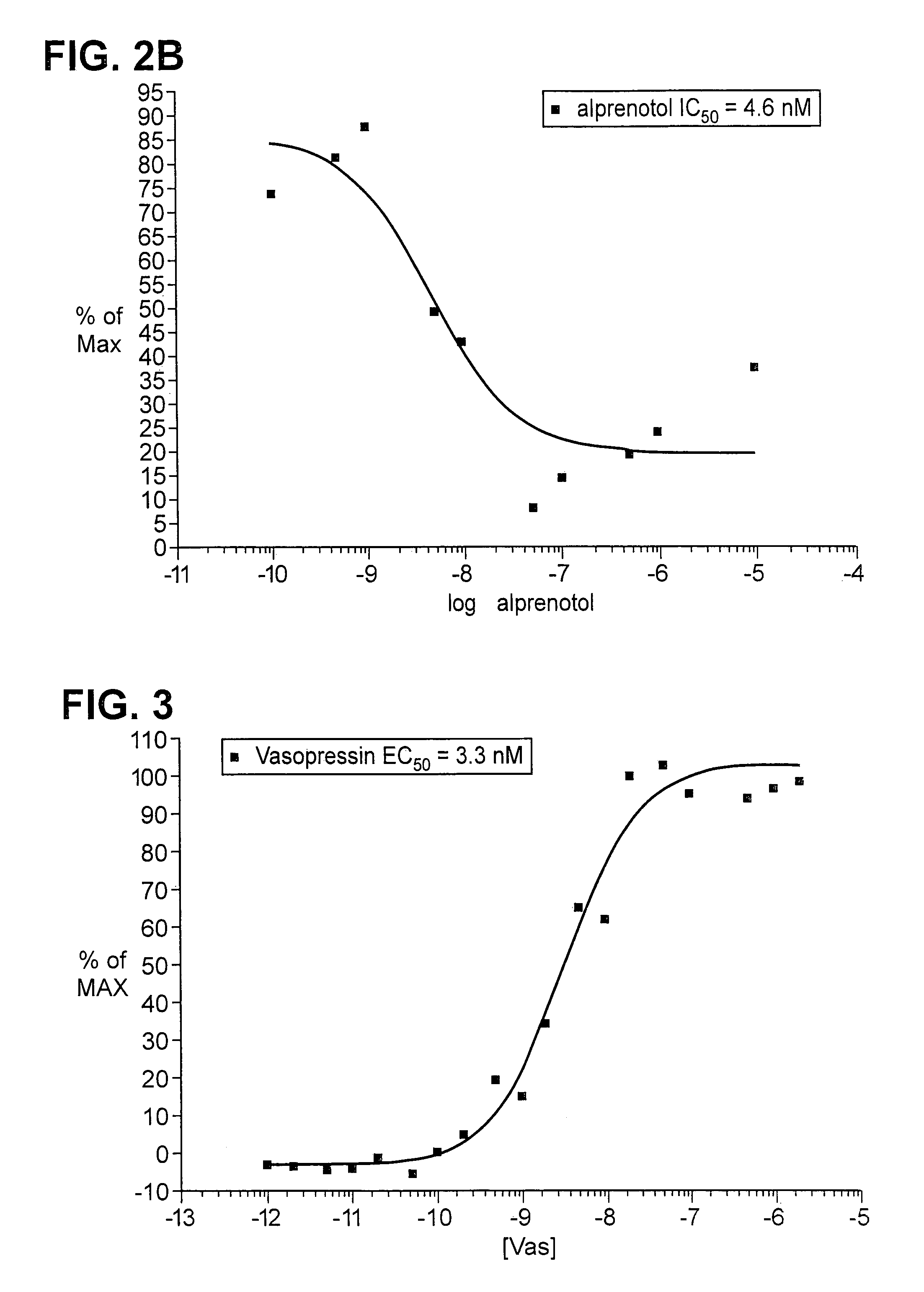Method for assaying protein—protein interaction
a protein and assay technology, applied in the field of assaying protein—protein interaction, can solve the problems of complex procedure, difficult to develop conventional g-protein assays for some targets, complex structure, etc., and achieve the effect of increasing interaction and higher affinity
- Summary
- Abstract
- Description
- Claims
- Application Information
AI Technical Summary
Benefits of technology
Problems solved by technology
Method used
Image
Examples
example 1
[0114]A fusion construct was created, using DNA encoding human β2 adrenergic receptor, referred to hereafter as “ADRB2”, in accordance with standard nomenclature. Its nucleotide sequence can be found at GenBank, under Accession Number NM—000024 (SEQ ID NO: 1). The tetracycline controlled transactivator tTA, described by Gossen, et al., Proc. Natl. Acad. Sci. USA, 87:5547–5551 (1992), incorporated by reference, was also used. A sequence encoding the recognition and cleavage site for tobacco etch virus nuclear inclusion A protease, described by Parks, et al., Anal. Biochem., 216:413–417 (1994), incorporated by reference, is inserted between these sequences in the fusion coding gene. The CMV promoter region was placed upstream of the ADRB2 coding region, and a poly A sequence was placed downstream of the tTA region.
[0115]A fusion construct was prepared by first generating a form of ADRB2 which lacked internal BamHI and BglII restriction sites. Further, the endogenous stop codon was rep...
example 2
[0133]A second construct was also made, whereby the coding sequence for “βarrestin 2 or ARRB2” hereafter (GenBank, NM—004313) (SEQ ID NO: 17), was ligated to the catalytic domain of the TEV NIa protease (i.e., amino acids 189–424 of mature NIa protease, residues 2040–2279) in the TEV protein. To do this, a DNA sequence encoding ARRB2 was modified, so as to add a BamHI restriction site to its 5′ end. Further, the sequence was modified to replace the endogenous stop codon with a BamHI site. The oligonucleotides
[0134]
caggatcctc tggaatgggg gagaaacccg(SEQ ID NO: 18)ggacc,andggatccgcag agttgatcat catagtcgtc(SEQ ID NO: 19)
were used. The resulting PCR product was cloned into the commercially available vector pGEM-T EASY (Promega). The multiple cloning site of the pGEM-T EASY vector includes an EcoRI site 5′ to the start codon of ARRB2.
[0135]The TEV NIa-Pro coding region was then modified to replace the endogenous start codon with a BglII site, and to insert at the 3′ end a sequence which en...
example 3
[0138]Plasmids encoding ADRB2-TEV-NIa-Pro cleavage site-tTA and the ARRB2-TEV-NIa protease fusion proteins were transfected into HEK-293T cells, and into “clone 41,” which is a derivative of HEK-293T, that has a stably integrated β-galactosidase gene under control of a tTA dependent promoter. About 5×104 cells were plated in each well of a 24 well plate, in DMEM medium supplemented with 10% fetal bovine serum, 2mM L-glutamine, 100 units / ml penicillin, 100 μg / ml G418, and 5 μg / ml purimycin. Cells were grown to reach 50% confluency the next day, and were then transfected, using 0.4 μg plasmid DNA, and 2 μl Fugene (a proprietary transfection reagent containing lipids and other material). The mix was combined in 100 μl of DMEM medium, and incubated for 15 minutes at room temperature prior to adding cells. Transfected cells were incubated for 8–20 hours before testing by adding drugs which are known agonists for the receptor, and then 16–24 hours after drug addition.
PUM
| Property | Measurement | Unit |
|---|---|---|
| pH | aaaaa | aaaaa |
| pH | aaaaa | aaaaa |
| affinity | aaaaa | aaaaa |
Abstract
Description
Claims
Application Information
 Login to View More
Login to View More - R&D
- Intellectual Property
- Life Sciences
- Materials
- Tech Scout
- Unparalleled Data Quality
- Higher Quality Content
- 60% Fewer Hallucinations
Browse by: Latest US Patents, China's latest patents, Technical Efficacy Thesaurus, Application Domain, Technology Topic, Popular Technical Reports.
© 2025 PatSnap. All rights reserved.Legal|Privacy policy|Modern Slavery Act Transparency Statement|Sitemap|About US| Contact US: help@patsnap.com



